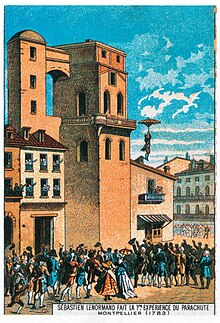Louis-Sébastien Lenormand
Louis-Sébastien Lenormand (born May 25, 1757 in Montpellier , † December 1837 in Castres) was a French physicist , inventor and pioneer of parachuting . Along with his compatriot André-Jacques Garnerin, he is considered to be one of the first people to have demonstrably succeeded in a parachute jump. He is also attributed the coining of the French term parachute, which is commonly used for parachutes .
Life
Lenormand was born in Montpellier in 1757, the son of a watchmaker . From 1775–80 he studied physics and chemistry with Lavoisier and Berthollet in Paris and then worked in his father's company. At the same time he began to develop an aircraft for rescuing people in burning buildings. After initial attempts at modified umbrellas , he refined his design and in 1783 jumped using a parachute with a rigid frame and a span of 14 feet (4.3 meters) from the tower of the observatory of the Academie Royale des Sciences (Royal Academy of Sciences) in Montpellier, where he landed unharmed.
After his successful parachute jump, Lenormand devoted himself to science and technology. He became a monk in a Carthusian monastery in Castres , where he was allowed to continue his studies. During the French Revolution he left the monastery, married and moved to Albi , where he accepted a teaching position in technology in a school founded by his father- in -law . In 1803 he moved to Paris . At this time he began his journalistic activities on technical topics and applied for patents for a considerable number of inventions. A clock he designed was successfully installed in the Paris Opera . In 1830 he returned to Castres. He had his marriage annulled and from then on lived as brother Chrysostom in the Charterhouse , where he died in December 1837.
Fonts (selection)
- Dictionnaire technologique, ou Nouveau dictionnaire universel des arts et métiers, et de l'économie industrial et commerciale . 20 volumes. Thomine et Fortic, 1822-37
- Annales de l'industrie nationale et étrangère: ou, Mercure technologique . Bachelier, 1823
- Nouveau manuel complet du relieur, dans toutes ses parties: précédé des arts de l'assembleur, du satineur, de la plieuse, de la brocheuse, et suivi des arts du marbreur sur tranches, du doreur sur tranches et sur cuir. Roret, 1840
literature
- Joost Mertens: Technology as the science of the industrial arts: Louis-Sébastien Lenormand (1757-1837) and the popularization of technology . In: History and Technology - An International Journal . tape 18 , no. 3 , 2002, ISSN 0734-1512 , p. 203-231 , doi : 10.1080 / 0734151022000034125 (English).
Web links
- Literature by and about Louis-Sébastien Lenormand in the catalog of the German National Library .
Individual evidence
- ^ History of the Parachute. In: About.com. New York Times Company , accessed November 1, 2009 .
- ^ Louis Guilbert: La formation du vocabulaire de l'aviation . Éditions Larousse, Paris 1965, p. 312 .
- ↑ Monuments historiques: Observatoire, Montpellier. In: CultureCommunication. Retrieved April 23, 2016 .
| personal data | |
|---|---|
| SURNAME | Lenormand, Louis-Sébastien |
| BRIEF DESCRIPTION | French physicist, inventor and pioneer of skydiving |
| DATE OF BIRTH | May 25, 1757 |
| PLACE OF BIRTH | Montpellier |
| DATE OF DEATH | December 1837 |
| Place of death | Castres (Tarn) |

